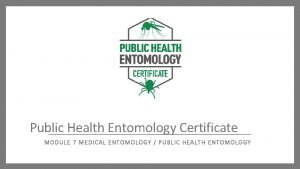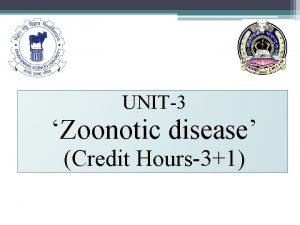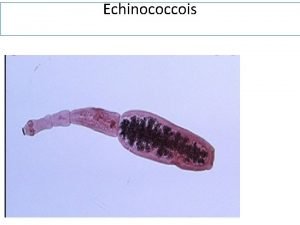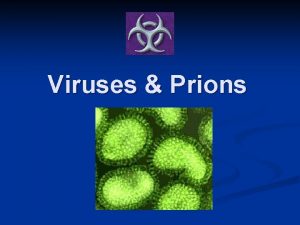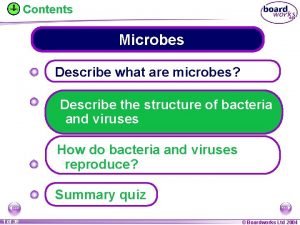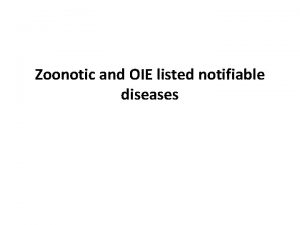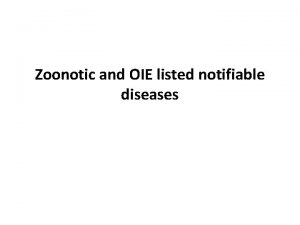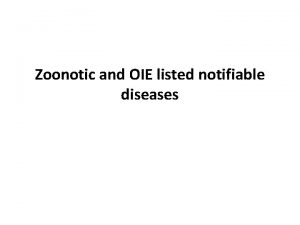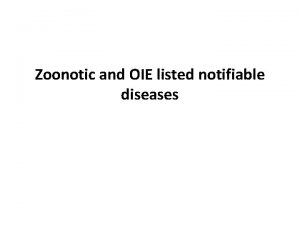UNIT3 Zoonotic disease Credit Hours31 Prions diseases q












- Slides: 12

UNIT-3 ‘Zoonotic disease’ (Credit Hours-3+1)

Prions diseases q Transmissible spongiform encephalopathies (TSEs) q Infectious amyloidosis q Unconventional slow virus degenerative encephalopathies

Introduction Prions diseases/ TSE are a family of: v Rare, Neurological disorder v Effects both humans and Animals v Characterized by: • long incubation periods • Neuronal loss • Failure to induce inflammatory response v Prion diseases are usually rapidly progressive and always fatal

Causative agent • Causative agents of TSEs are believed to be “PRIONs” • Termed: Prusiner (1982) • Dia. 25 -50 nm in size • Able to induce abnormal folding of specific normal cellular proteins called prion proteins Ø Prion proteins: most abundantly in the brain Ø Abnormal folding leads to brain damage Ø The prions is resistant to physical (high temp. UV rays) & chemical agents Ø It is non-immunogenic & highly stable molecule Ø It produces slow and progressive infection

Identified Prion Diseases Animal Prion Diseases Host effected Bovine Spongiform Encephalopathy (BSE) Cattle Chronic Wasting Disease (CWD) Deer Scrapie Sheep and Goats Transmissible mink encephalopathy Mink Feline spongiform encephalopathy Cat Ungulate spongiform encephalopathy

Identified Prion Diseases Human Prion Diseases Creutzfeldt-Jakob Disease (CJD) Variant Creutzfeldt-Jakob Disease (v. CJD) Gerstmann-Straussler-Scheinker Syndrome Fatal Familial Insomnia Kuru

Bovine Spongiform Encephalopathy (BSE) • Also K/as: Mad Cow Disease • Characterized by a progressive degenerating condition giving rise to spongiform appearance of the brain • Host: A progressive neurological disorder of cattle • Geographical Distribution: United Kingdom • History: – The first case of BSE in a cow: 1985 – Officially Diagnosed in: 1986 – BSE became a notifiable disease in: June, 1988 – Feeding of cattle / sheep offal to other beef cattle was banned : July, 1988 – Bovine offal was banned for human consumption in U. K. and Scotland from 1989

Bovine Spongiform Encephalopathy (BSE) • Symptoms: – Changes in mental state & behavior – Apprehension & excitability – Fixed gaze & humpback – Postural anomalies – Locomotor dysfunction – Ataxia – Tremor – Falling • Transmission: Consumption of beef or beef products

Bovine Spongiform Encephalopathy (BSE) • Diagnosis: – Clinical sign &symptoms – Based on histopathology • Prevention & Control: Ø Thoroughly cooked beef & beef products before consumption Ø Issue of animal health certificate from the government veterinary authorities of exporting countries Ø BSE free certificate: the animals imported from these countries into India Ø Create public awareness: education about it potential health hazards Ø Careful handling of animals/ meat: particularly the brain or spinal cord tissues

Creutzfeldt-Jakob Disease (CJD) § • v v v Subacute spongiform encephalopathy Rare brain disease: Effects one person per million population/year Etiology: Classic CJD Host: Human Geographical Distribution: – World wide mainly, United States – Higher incidence in cities v Sources of infection: – Ingestion of brain & other tissue of scrapie infected sheep v Disease: • Incubation Period: Infection with this disease leads to death usually within 1 year of onset of illness

Creutzfeldt-Jakob Disease (CJD) • Symptoms: – Rapid onset of dementia, – a range of neurological symptoms – i. e. walking difficulties – Sudden jerky movements, – Sometimes, – Visual disturbances v Diagnosis: – Clinical sign – Histopathology-CNS – MRI v Treatment: Only supportive treatment v Prevention: Care during the handling of infected material & disinfection v CJD is not transmissible from person-to-person by normal contact

Variant Creutzfeldt-Jakob Disease (v. CJD) Characteristic Classic CJD Variant CJD Median age at death 68 years 28 years Median duration of illness 4 -5 months 13 -14 months Clinical signs and symptoms Dementia; early Prominent psychiatric/behavioral neurologic signs symptoms; painful dyesthesiasis; delayed neurologic signs Periodic sharp waves electroencephalogram “Pulvinar sign” on MRI* on Often present Not reported Often absent Present in >75% of cases Presence of “florid plaques” on Rare or absent neuropathology Present in large numbers Immunohitochemical analysis of Variable brain tissue accumulation Marked accumulation of proteaseresistance prion protein Presence of agent in lymphoid Not tissue detected readily Readily detected Increased glycoform ratio on Not reported immunoblot analysis of proteaseresistance prion protein Marked accumulation of proteaseresistance prion protein
 Zoonotic diseases
Zoonotic diseases Zoonotic
Zoonotic Zoonotic
Zoonotic Prions
Prions Study guide chapter 18 section 1 bacteria
Study guide chapter 18 section 1 bacteria Are prions alive
Are prions alive Mad cow disease in humans
Mad cow disease in humans Communicable disease and non communicable disease
Communicable disease and non communicable disease This can be avoided by giving credit where credit is due.
This can be avoided by giving credit where credit is due. Chapter 24 sexually transmitted diseases and hiv/aids
Chapter 24 sexually transmitted diseases and hiv/aids Purulent diseases of lungs and pleura
Purulent diseases of lungs and pleura Communicable and noncommunicable diseases venn diagram
Communicable and noncommunicable diseases venn diagram Microbes
Microbes
